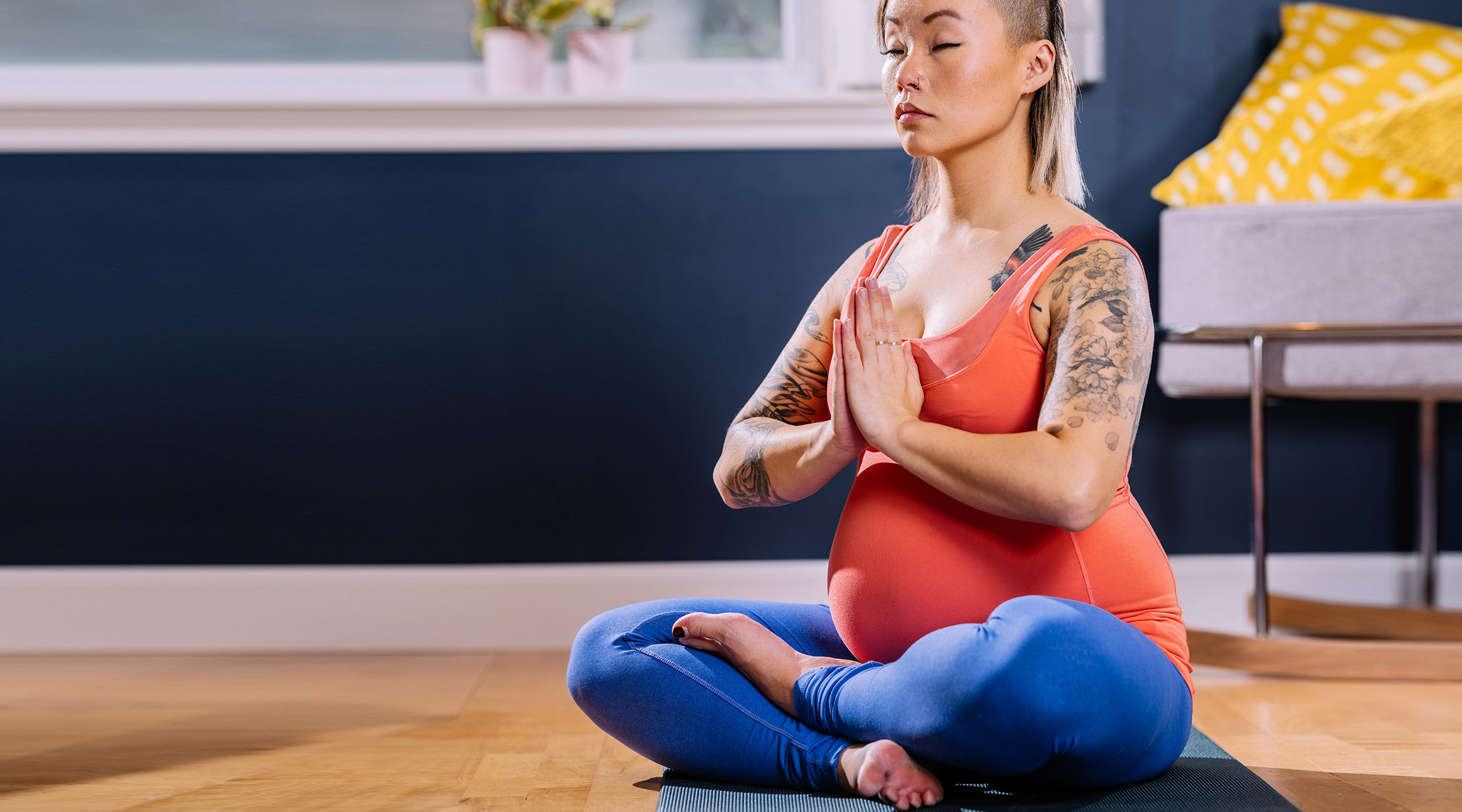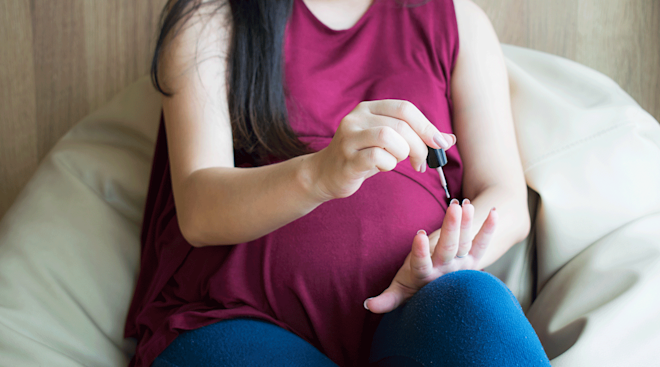How to Find Your Inner Zen With Pregnancy Meditation
Your health is so important, especially during pregnancy—and that includes your mental health as well as your physical health. To find a little zen, many moms-to-be swear by pregnancy meditation. And for good reason too: it boasts tons of benefits. But how do you know if it’s right for you? And if it is, how can you incorporate it into your already crammed routine? Here, we walk you through the whys and hows of pregnancy meditation. Spoiler: It’s easier to practice than you think.
First things first: What is meditation? Basically, it’s the practice of focusing your mind to achieve a calm and clear mental state. You might focus on an activity (like breathing) to draw yourself into the present instead of worrying about the past or future. Or, you might focus on a mantra to set an intention that’ll bring you peace. Really, it’s all about non-judgemental observation and awareness. Pregnancy meditation is just meditation catered to this very special time in your life.
If there’s one person who knows all about the upsides of pregnancy meditation, it’s Anna Gannon, the Community Guide for the pregnancy meditation app Expectful and a meditating mom herself (check out the photo of her and her daughter below!). “At Expectful, we call meditation ‘prenatal vitamins’ for your mind,” she explains. Why? Because studies link it to a whole host of benefits before, during and after pregnancy, including:
• Reduced stress. There’s a lot to think about (read: fret over) when you’re expecting, but meditating regularly during pregnancy can significantly reduce anxiety. (It can also help calm you pre-pregnancy, which may boost fertility.)
• Balanced hormones. When you’re pregnant, your hormones sort of go haywire. Thankfully, research shows that meditation influences hormone centers for the better.
• Less labor pain. Researchers found that meditators have lower pain sensitivity, meaning practicing could make childbirth—and postpartum recovery—easier.
• A stronger immune system. According to Expectful, meditation enhances the body’s immune function. This is especially helpful during pregnancy when your immune system is compromised, and the list of safe remedies is limited.
• Stronger relationships. Pregnancy meditation can improve connectivity between moms, their partners and their children. “I’ve seen this lead to happier and more joyful parents and babies,” Gannon says—including within her own family.
Meditating doesn’t just combat the negative effects of pregnancy. “It’s about the beautiful parts as well,” Gannon says. According to her, the more you meditate, the better you get at savouring your journey.
Convinced pregnancy meditation is worth a try? Read these tips before giving it a go.
When to meditate
Wondering when is a good time to meditate? Really, whenever! Gannon encourages women to meditate anytime during their pregnancy. Some even find it helpful to meditate while in labor. Of course, you can also continue practicing well after birth.
If you want to turn pregnancy mediation into a lasting habit, Gannon recommends practicing at the same time every day. Choose this time based on your schedule and when you’re most likely to really commit. “If you’re a morning person, perhaps you meditate every morning in bed before your feet hit the ground,” she says. Or, if you like going for long strolls, try daily walking meditations.
How long to meditate for
The duration of your pregnancy meditation is totally up to you. “Even taking just one mindful breath can be powerful,” Gannon notes, with one caveat: “The longer you sit, the more time you have to settle into your body and calm your mind.” Expectful offers all its meditations in three lengths: five minutes, 10 minutes and 20 minutes. That way, you can pick whatever session works best for your lifestyle.
What position to meditate in
There’s also no one pose you have to meditate in—go ahead and sit, lie down or stand. “However, within the second and third trimester, we do ask women to avoid laying flat on their backs, as the additional weight of their growing baby can compress the major blood vessel in their body, called the vena cava. This can in turn affect the blood flowing to the baby,” Gannon advises.
Where to meditate
Again, it depends. “Some meditate while walking or in their parked car before or after leaving for work,” Gannon says. “Others meditate in their doctor’s office before a checkup or test. Still others meditate on the subway, on their couch or anywhere else where they feel they (a) need to find calm and (b) are comfortable.”
And despite what you might think, you don’t have to meditate alone! “We believe meditating with your partner is a great way to connect as a couple while also giving your partner space to connect with baby,” Gannon says. “Taking mindful time out of the day to just be with one another is truly a beautiful thing.”
At the end of the day, do what feels right. “It’s about listening to what you need in the moment and responding,” Gannon explains. “By empowering yourself through things like meditation, you create a ripple effect, leading to you feeling more empowered during pregnancy, labor, postpartum and motherhood. The more we can listen to our own unique needs, the more empowered we feel to continue to do that in all areas of our lives.”
Got the gist of pregnancy meditation but need a little structure to get started? Try a guided meditation led by an instructor. But know that you can also incorporate unguided meditations into your everyday life. We’ve outlined a few examples of both below.
Guided pregnancy meditations
Whether you attend a class or download an app to listen to at home or on the go, there are tons of different pregnancy meditations to try. Take Expectful’s especially comprehensive assortment. Want to learn more about baby’s development? Try its trimester-specific offerings that address your child’s stage week by week. Worried about labor? Try the ones centered around preparing for birth. Planning ahead for the newborn stage? Good news, mamas: Expectful is expanding its collection to include libraries full of postpartum and motherhood-based meditations. Healing meditations for parents who have suffered losses are also in the works.
Unguided pregnancy meditations
If a DIY approach is more up your alley, walk yourself through these mantras and simple practices for different pregnancy stages. Gannon, who writes many of Expectful’s meditations, dreamt them up herself.
First trimester: The first trimester is full of uncertainty, so at this stage, Gannon recommends building trust. Try repeating this phrase whenever you need a confidence boost: “I trust my baby, I trust myself, I trust my journey.”
Second trimester: “In the second trimester, your body begins to change and the reality of being pregnant not only sets into your mind but in your physical appearance as well,” Gannon says. “While some women find themselves feeling amazing during this physical transition, others may struggle with it. So for this trimester, I recommend connecting with gratitude.” Try writing down or saying (out loud or silently to yourself) three things you’re grateful for each day. You might say thanks for your baby, the strength your body has shown or your loving partner.
Third trimester: During the third trimester, it’s easy to get overwhelmed with your growing list of to-dos—not to mention your growing belly. Gannon recommends taking a break from worrying about what’s next and appreciating this special time in your and baby’s adventure together. For that, make “be here” your mantra.
Labor: Try inhaling with the thought “let” and exhaling with the thought “go.” “This can support women during contractions, allowing them to be aware of when they’re clenching or holding onto unnecessary tension,” Gannon explains. “It also allows the mind to release from thinking, giving the body space to do what it naturally knows how to do. It supports both your body and baby as they work together.”
With your partner: Even with a partner by your side, pregnancy can feel like a solo experience. They aren’t the ones with nausea or getting kicked constantly, after all. An easy way to feel more in-sync with your partner? Ask them to place their hands on your belly and sit together in mindful silence, feeling your body (and baby) in unison. As Gannon says, “Taking time to just be together as a family can be so helpful during this time.”
This information is prepared for informational purposes only. The Knot Worldwide and its affiliates do not recommend or endorse any specific tests, physicians, products, procedures, opinions, or other information that may be mentioned herein. You should consult with your healthcare provider about your specific health needs. You should always speak with your doctor before you start, stop, or change any prescribed part of your care plan, exercise program or treatment.
Published April 2019
Please note: The Bump and the materials and information it contains are not intended to, and do not constitute, medical or other health advice or diagnosis and should not be used as such. You should always consult with a qualified physician or health professional about your specific circumstances.
Plus, more from The Bump:
Navigate forward to interact with the calendar and select a date. Press the question mark key to get the keyboard shortcuts for changing dates.





















































